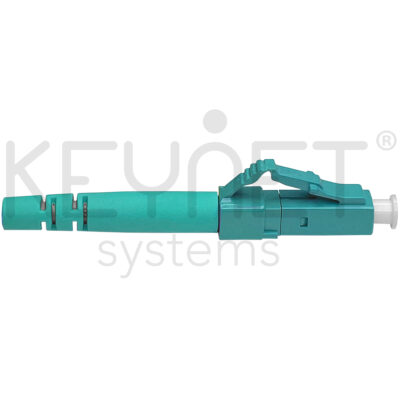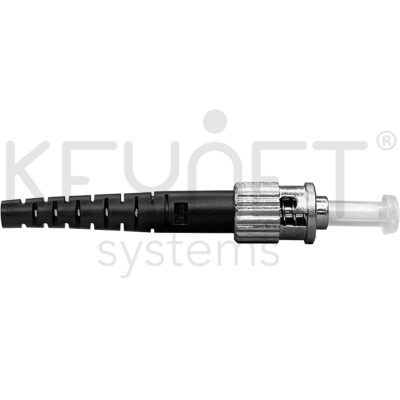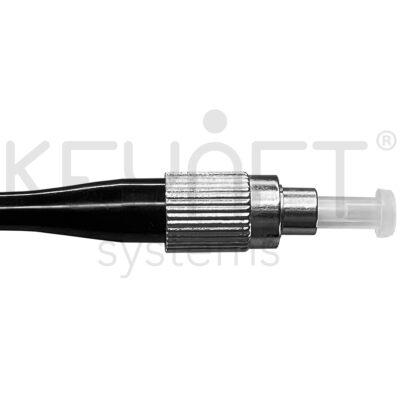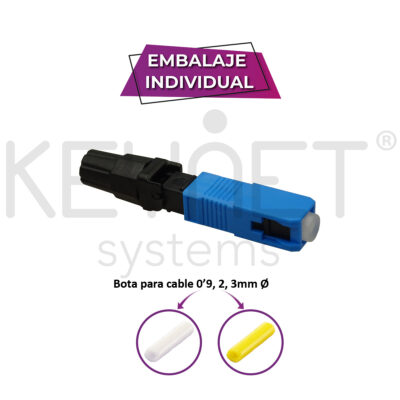Types of fibre optic connectors
Nowadays, we can see how the use of fibre optics for data transmission is becoming more and more common in all types of communications systems. With fibre, millions of bots per second can be transmitted, allowing access to a high-speed, high-quality service.
Connectors do not distinguish between single-mode (SM) and multimode (MM) fibre, as even if they have a different core (9-10μ” for single-mode and 62.5 or 50μ” for multimode), the cladding or cladding is 125μ” for both.
In plastic connectors such as LC or SC the body will be of a different colour and will indicate the type of fibre used and the polish of the ferrule.
SC, LC, ST and FC connectors have a ferrule through which the fibre passes. When connectors are fitted to the equipment, through the adapters, the light or signal passes from one ferrule to another without transition elements, which allows the insertion loss to be very low (around 0.25dB/Km).
The connectors allow easy coupling of the fibre optic cable to the elements that will work as receivers and transmitters. Depending on the use, there are different types of connectors. The most common ones are listed below:
Lucent Connector or LC type connector
It is also known as Little Connector, as it offers a small and compact design.
It has a pull-proof mechanism and is available for single-mode and multimode fibres. Its ferrule is 125μ”. In addition, its size reduces the space requirement by up to 50 % compared to its SC, FC or ST counterparts and is often used in high-density systems such as patch panels or interconnect panels and mostly in data centres.
The connector body is plastic and therefore the type of fibre and polish used can be distinguished through colour.

Conector Standard Connector o SC
It is the most common connector used for fibre optics. It has a push-pull coupling mechanism. It is available for single-mode and multimode fibre cables and accepts the 3 types of polishing PC, UPC and APC. Their ferrule is 250μ” and their configuration allows them to withstand >500 connection and disconnection cycles.
The body of the connector is plastic and therefore the type of fibre and polish used can be distinguished through colour.
The SC is the most commonly used connector in FTTh network installations.

Straight tip or ST type connector
Also known as straight tip connectors. This type of connector offers a bayonet ferrule design that allows the fibre to be held for quick and easy alignment. Its mating mechanism ensures that there is no slippage or disconnection. The ferrule is 250u”. It is available for singlemode and multimode fibres and accepts PC and UPC polishes.
The connector body is metallic and therefore it is not possible to distinguish through colour the type of fibre and polish used.
ST connectors are used in military equipment or applications but their use has declined considerably and is more commonly found in demand in maintenance installations.

Ferrule Connector or FC type connector
This type of fibre optic connector features a threaded design, allowing it to be securely fastened to the adapter. Its ferrule is 250u”. It is available for single-mode and multimode fibres and accepts PC and UPC polishes.
The body of the connector is metallic and therefore it is not possible to distinguish through colour the type of fibre and polish used.
They are generally used in measurement equipment and environments where vibration is present.

MPO/MTP type connector
This type of fibre optic connector stands out because it can hold from 12 to 24 fibres due to its rectangular ferrule design. It is used in the construction of Ethernet networks for 40G and 100G parallel transmission.
It should be noted that there are two versions for this type of connector, being the UPC whose ferrule ends in a curved-convex surface and APC whose ferrule ends in a flat and inclined surface. Their insertion loss is 0.25 dB.
The MPO and MTP connectors have 2 metal pins that help the perfect alignment of the fibres. For this reason they are distinguished in male (with pins) and female (with pin holes) versions.

Mechanical fibre connectors
Mechanical connectors, also known as quick connectors, allow the fibre cable to be connected to the receiver or transmitter without the need for fusion splicing.
Their design allows the cable fibre to be aligned with the fibre mounted inside the ferrule by contact. Despite being a hand-assembled connector, it offers good accuracy, with an insertion loss of 0.5 dB.

How to choose the best fibre optic connector for your application?
Despite the variety of connectors currently available, their use will depend solely on the application and the environment to which they are subjected.
The SC connector is an inexpensive connector used for FTTh networks connecting the ONT to the PTRO.
On the other hand, LC type fibre optic connectors are often used in professional switch SFP transceivers.
The FC type connector has declined in use with the advent of SC and LC connectors, although it is still useful for environments subject to vibration.
Finally, the ST connector is used in professional and military environments. Its design is very similar to the FC type connector, with the difference that it fits like a bayonet mount connector, but its use has declined significantly in recent years.
Ultimately, it is the active equipment and the transition or patch panels with their adapters that will force us to choose one type of connector or another, as well as the polishing of the PC/UPC or APC ferrule. Never forget that a connector with PC polishing is compatible with a UPC and vice versa, but APC polishing is not compatible with any of the above.
Discover the complete range of fibre optic connectors.
For more information on this or other Keynet products, please visit our website, contact our distributors or send an email to info@keynet-systems.com.
